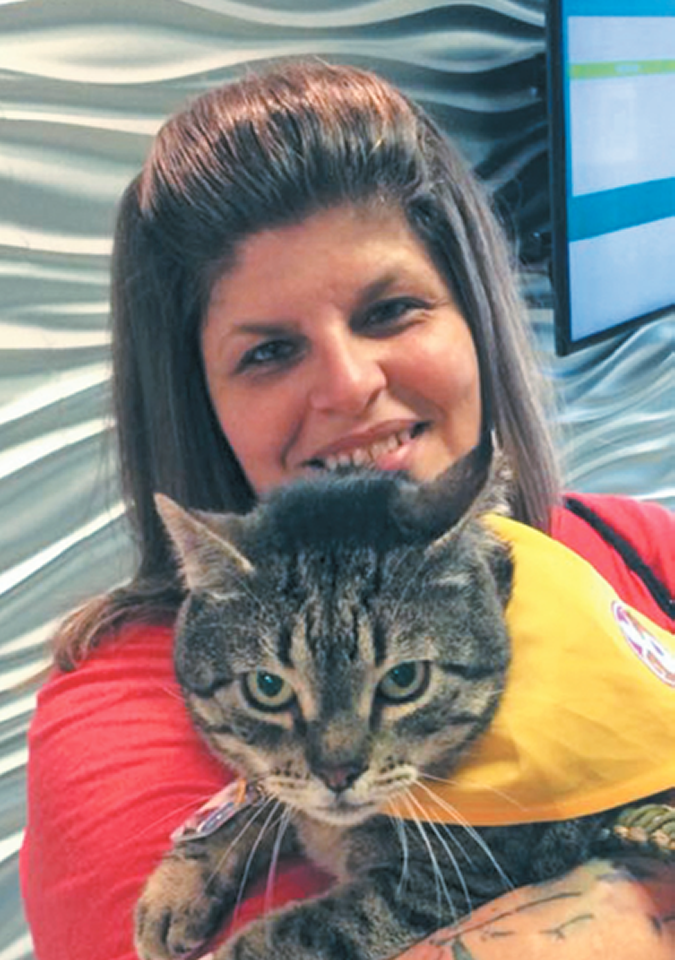You’ve most likely heard of therapy dogs, who offer comfort to hospital patients, stressed out college students, children with disabilities, and others in need. But therapy cats? Yes, therapy cats spread cheer to strangers, too — and these interactions not only enrich the lives of the people they visit but also those of the cats themselves.
Cats enjoy mental stimulation from therapy work as long as they participate in a program that ensures they are safe and enjoy the task, says Deborah Linder, DVM, co-director of the Tufts Institute for Human Animal Interaction.
In addition, Dr. Linder says, “I think it reinforces the bond they have with their owner. It’s a really positive thing that doesn’t involve giving extra calories and getting a cat overweight.”
Does your cat have the right temperament for therapy work?
There are more than 180 registered cat-human therapy teams in the United States, according to Elisabeth Van Every, communications and outreach coordinator for the non-profit Pet Partners, a national program for therapy animals. Skills for a therapy cat include positively reacting to strangers and being touched and carried; being able to walk through a facility on leash; being placed on people’s laps without immediately moving away; and responding well to the presence of a dog, since therapy cats are likely to encounter therapy dogs while visiting. They also have to be comfortable being transported in a carrier in a car for travel to the facilities they visit.
“All therapy animals need an affiliative nature, meaning they enjoy and even seek out interactions with people, and enjoy being petted,” Ms. Van Every explains.
How to register as a therapy cat team
To register as a therapy cat team with Pet Partners, you and your feline will both be tested. The evaluator will examine how well the cat responds to various situations, and how well you, the handler, manage and advocate for your pet.
All therapy animal teams are re-evaluated every two years. Owners are expected to know when their cat is reaching a “done point” and when to end stressful interactions or an entire visit — before a cat becomes fatigued and grumpy, because safety and animal welfare are top priorities.
Ms. Van Every’s suggestions for cat owners who’d like to volunteer on a therapy animal team include:
-Train your cat in wearing a harness and leash as soon as possible.
-Help your cat get used to traveling comfortably in a vehicle.
-Give your cat opportunities to socialize and visit new places, such as the homes of friends and family, pet supply stores, and warehouse-style hardware stores.
-Be prepared for regular grooming, since infection control is a major concern in therapy animal work.
-Keep your cat’s claws short.
-Get your cat comfortable with periodic bathing and wipe-downs of coat and paws.
“A cat who loves meeting new people, being touched, and thrives on attention, and one who handles unexpected circumstances without much stress, will be the best candidate for therapy work,” she says. “Pet Partners knows that not every cat is suited to being a therapy animal, but we are committed to supporting those that are.”
For more information:
Pet Partners: https://petpartners.org/
https://hai.tufts.edu/paws/ (Tufts University partners with Pet Partners to offer this program.)


Meet Therapy Cat Team Frankie and Carrie
Carrie Reilly and her cat Frankie share a special bond that grows stronger every day. The Louisiana resident rescued the Manx as a stray injured in a dog attack; he repaid the favor by helping her cope with PTSD in the wake of her husband’s suicide after military service.
“He has shown me unconditional love can heal a broken heart,” she shares.
Because Frankie is so loving, Ms. Reilly had him evaluated as a therapy cat for the nonprofit Pet Partners. Now they volunteer together visiting patients at a nursing home to spread cheer. Residents delight in seeing Frankie walk around on his leash and petting him on their laps. Best of all, Frankie seems to love his job.
“He enjoys people,” Ms. Reilly says. “It’s like he comes alive when he meets new people and goes places with me …
I will put him on the lap of someone at the nursing home, and he immediately settles down and starts to purr and knead his paws. He gets this look of contentment on his little face.”
Ms. Reilly always trusts that Frankie will be gentle with the people they meet, and she is grateful to share such a meaningful activity with her best friend.
“I think that Frankie gets comfort in helping people,” she says.
Reading your cat’s body language for a safe visit
Even if your cat seems comfortable with being petted by strangers, Tufts’ Dr. Linder says it’s crucial to monitor the cat for signs of stress. These include:
-Pinned ears
-Whale eye — wide-open eyes with the whites showing
-Tail sticking straight up
-Yawning
-Minor vocalization
-Turning her head away from the person or other stimulus
-Lip smacking
Ultimately, being attuned to your cat’s body language and reacting accordingly — such as by taking a break when she seems stressed — improves a cat’s therapy



